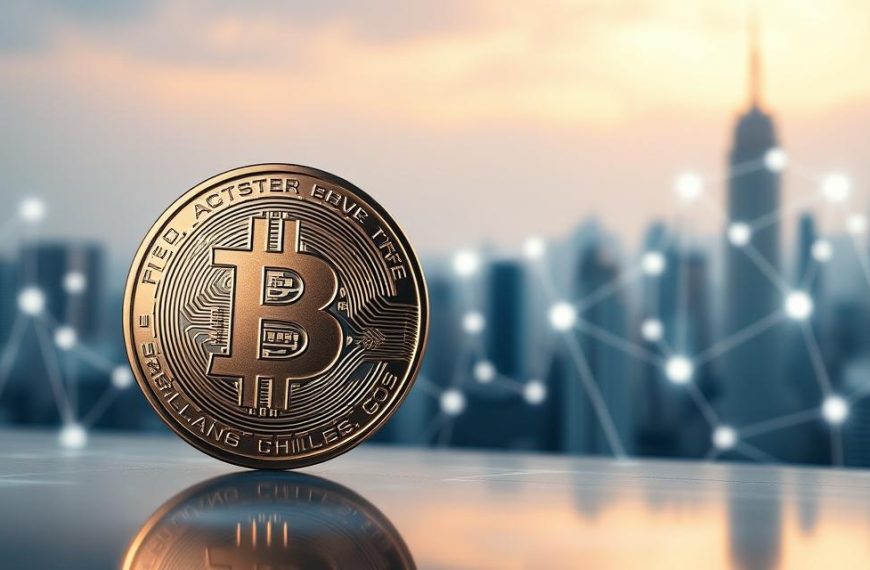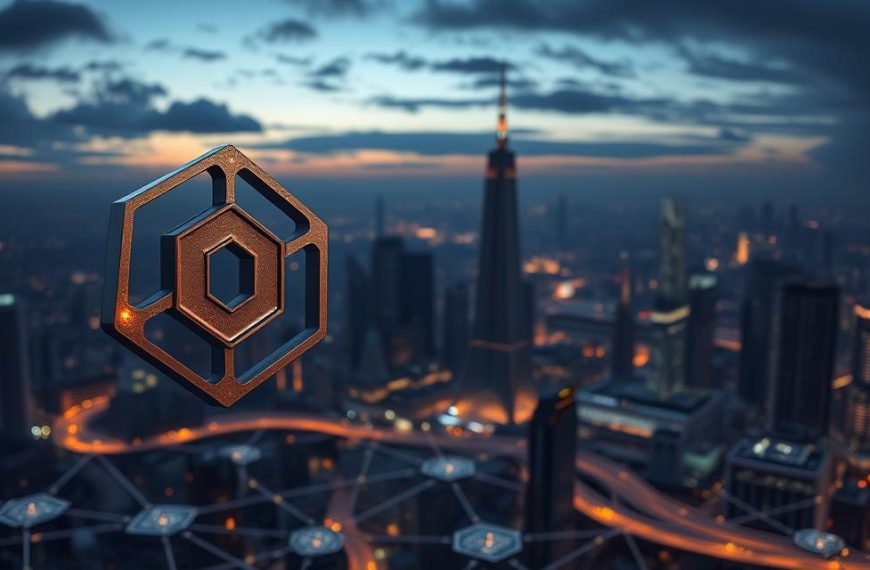The digital asset world, including cryptocurrencies, has grown a lot lately. Investments in Bitcoin ETFs can change how digital assets are priced. Fintech projects are also making digital assets more common in our daily lives.
As the crypto world grows, it’s key to know its main parts. This includes blockchain technology and the rise of decentralized finance.
The crypto world is vast, with over 20,000 cryptocurrencies and a market worth about $2.1 trillion. It’s important to grasp the rules and how big players affect the market. Around 20% of Americans have dabbled in cryptocurrencies, and about 46% know what they are.
What is Crypto World?
The crypto world is a fast-changing space. It includes many digital assets like cryptocurrencies and tokenized money. It’s built on blockchain technology, which makes transactions safe and open.
By June 2023, over 25,000 cryptocurrencies existed. More than 40 had a value over $1 billion. This shows digital assets are becoming more common in our lives.
Defining Digital Assets
Digital assets fall into several groups. Cryptocurrencies, like Bitcoin, are digital money that’s secure. Tokenized money and assets are digital versions of things like stocks and bonds.
The Evolution of Cryptocurrency
Bitcoin was the first cryptocurrency in 2009. Ethereum came in 2015. Since then, many new cryptocurrencies have appeared. Bitcoin is now legal money in El Salvador, and Ethereum has changed its way of working.
Key Components of the Crypto Ecosystem
The crypto world has a few main parts. Blockchain technology is the base, making transactions safe and open. Digital wallets and exchanges let users manage their digital assets.
The Technology Behind Digital Assets
The core of digital assets, like cryptocurrency, is blockchain technology. It allows for a decentralized ledger, a shared public database. This database records transactions across many computer systems.
The blockchain is made of blocks. Each block has information about the previous blocks. This ensures the ledger’s integrity and order.
Blockchain technology makes secure and transparent transactions possible. This is crucial for cryptocurrency transactions, which need strong security to avoid fraud. It also enables the creation of cryptocurrency wallets. These wallets help users store and manage their digital assets safely.
This technology could change how we view money and financial transactions. With blockchain technology and decentralized ledger, we can have a more secure, open, and efficient financial system. As cryptocurrency and other digital assets grow, we’ll see more creative uses of this tech.
Understanding Blockchain Architecture
Blockchain architecture is key to cryptocurrencies and digital assets. It uses a distributed ledger for secure, open, and unchangeable transactions. This technology makes a network where everyone has the same ledger, keeping data safe and reliable.
Blockchain’s safety comes from consensus mechanisms. These check transactions and make sure everyone agrees on the ledger. Complex algorithms need lots of power, making it hard for hackers to alter the network.
Distributed Ledger Technology
Distributed ledger technology is at the heart of blockchain. It creates a network where everyone has the same ledger. This ensures data is consistent and trustworthy. It’s used in many areas, not just for money, like managing supplies and voting systems.
Consensus Mechanisms
Consensus mechanisms are vital for blockchain’s safety. They verify transactions and ensure everyone agrees on the ledger. There are different types, like proof of work and proof of stake, each with its own strengths and weaknesses.
Smart Contracts and Their Applications
Smart contracts are programs that carry out agreements automatically. They are stored on the blockchain, making them secure and open. They’re used in many ways, like managing supplies, voting, and handling money. They make processes more efficient by cutting out middlemen.
| Blockchain Type | Security | Decentralization |
|---|---|---|
| Public Blockchain | High | High |
| Private Blockchain | Low | Low |
| Consortium Blockchain | Medium | Medium |
In summary, blockchain architecture is complex. It uses distributed ledger technology, consensus mechanisms, and smart contracts for secure transactions. Knowing about these parts helps us see the power of blockchain and its many uses.
Major Cryptocurrencies and Their Unique Features
The world of cryptocurrencies is full of variety. Each digital asset has its own special features and uses. Bitcoin and Ethereum are at the top, with big market values and lots of users. On February 7, 2025, Bitcoin’s value was about $1.93 trillion. Ethereum’s was nearly $329.5 billion.
Other big names include Tether (USDT), Binance Coin (BNB), Solana (SOL), and USD Coin (USDC). Each has its own unique traits. For example, Tether is always worth $1, like the U.S. dollar. Solana, with a value of $96 billion, is trading at about $196.9.
Here are some key features of these cryptocurrencies:
- Bitcoin: The most widely recognized cryptocurrency, with a market capitalization of $1.93 trillion.
- Ethereum: A foundational technology in the blockchain ecosystem, with a market capitalization of $329.5 billion.
- Tether: A stablecoin pegged to the U.S. dollar, with a market capitalization of $141.4 billion.
- Solana: A fast and scalable blockchain platform, with a market capitalization of $96 billion.
The cryptocurrency market is always changing. New digital assets appear, and old ones adapt. It’s key to know what makes each one special, like Bitcoin and Ethereum. This helps you make smart investment choices.
Below is a quick look at the current market values and prices of some major cryptocurrencies:
| Cryptocurrency | Market Capitalization | Price |
|---|---|---|
| Bitcoin | $1.93 trillion | $93,964.55 |
| Ethereum | $329.5 billion | $3,290.25 |
| Tether | $141.4 billion | $1.00 |
| Solana | $96 billion | $196.9 |
The Role of Digital Wallets and Exchanges
Digital wallets and crypto exchanges are key in the crypto world. They let users store, send, and get cryptocurrencies. The first wallet was made by Bitcoin’s creator, Satoshi Nakamoto. Now, we have many types, like custodial and non-custodial wallets.
Keeping digital wallets and exchanges safe is very important. Security best practices like encrypted wallets and strong passwords are needed. This is because cyber threats are common, especially against exchanges.
Types of Crypto Wallets
There are many crypto wallet types, like hardware, software, and paper wallets. Hardware wallets, like Trezor and Ledger, are very secure. They keep private keys offline. Recently, hardware wallet sales have grown by over 150% in 2022.
Centralised vs Decentralised Exchanges
Centralized exchanges (CEXs) handle over 90% of all trades. Big names like Binance and Coinbase lead the market. But, decentralized exchanges (DEXs) are growing fast, with a 200% increase in trades last year. Here’s a comparison of CEXs and DEXs:
| Exchange Type | Trading Volume | Security |
|---|---|---|
| Centralized Exchanges (CEXs) | Over 90% of total trading volume | Vulnerable to cyber attacks |
| Decentralized Exchanges (DEXs) | Approximately 200% year-on-year growth | More secure, with reduced risk of cyber attacks |
In summary, digital wallets and crypto exchanges are vital in the crypto world. Security best practices are key to fight cyber threats. Knowing about different wallets and exchanges helps users store and trade cryptocurrencies safely.
Decentralised Finance (DeFi) Explained
Decentralised finance, or DeFi, is a new way of banking that uses blockchain technology. It lets people do banking without needing banks or brokers. Decentralized finance is becoming big in the crypto world, thanks to lending protocols and stablecoins. It works on blockchain, making it easy for people to trade directly with each other.
DeFi has many good points. It’s cheap to use, offers high returns, and is easy for everyone to get into. People can make more money in DeFi than in traditional banks. Lending protocols like Aave and Compound let people borrow money using their crypto as collateral. Lenders get a share of the interest.
Some interesting facts about DeFi include:
- Billions of dollars worth of digital assets are used in DeFi services like lending and savings.
- dYdX Chain lets users trade cryptocurrency with up to 20x leverage, keeping full control over their funds.
- Aave’s flash loans offer huge amounts of money with very low fees, as long as the loan is paid back in 13 seconds.
In summary, DeFi could change the financial world by making banking more open and fair. As it grows, we’ll see more people using DeFi for their financial needs.
Non-Fungible Tokens (NFTs) and Digital Ownership
NFTs have changed how we view digital ownership. They are unique digital items that can show ownership of many things. This includes art, collectibles, virtual land, and even event tickets.
The NFT market has grown fast, hitting over $2 billion in sales in the first quarter of 2021. But, it faced a big drop in 2022 and 2023. This was due to too many NFTs being traded, with over 1.5 million each month.
Despite these issues, NFTs still have many uses. They can be used for digital art, collectibles, virtual land, and event tickets. They also have the power to change the music industry. Musicians can connect more with fans and keep more control over their work.
Some key benefits of NFTs are:
- Unique digital ownership
- Decentralized and secure
- Wide range of use cases
- Potential for high returns on investment
The NFT market is set to grow even more, with a 32% annual growth rate from 2022 to 2028. As it grows, we’ll see new and exciting ways NFTs are used. This will make them even more important in the world of digital ownership.
| NFT Market Statistics | 2021 | 2022 |
|---|---|---|
| Market capitalization | $41 billion | $20 billion |
| Number of NFT transactions | 1.5 million | 500,000 |
Regulatory Landscape and Compliance
The world of cryptocurrency is complex and always changing. Governments everywhere are making rules to handle the rise of digital money. In the European Union, they want to stop bad uses of digital money. In the U.S., the SEC has taken action against companies like Ripple and Coinbase.
Places like Canada, Japan, and Australia have rules for digital money trading. The tax implications of digital money deals are also being looked at. For example, India taxes digital money investments at 30% and has a 1% tax on trades.
The regulatory landscape is changing fast and is different everywhere. Here are some important things to know:
- Money Services Businesses (MSBs) and Money Transmitter Licenses (MTLs) need to follow the Nationwide Multistate Licensing System & Registry (NMLS).
- The IRS now requires new reports for digital money and asset deals.
- Regulators stress the need for protecting users and say stablecoin makers should be banks.
For those in the digital money world, knowing the cryptocurrency regulations and tax implications is key. Keeping up with the regulatory landscape is crucial to avoid trouble and stay legal.
| Country | Regulatory Framework | Tax Implications |
|---|---|---|
| U.S. | SEC and CFTC regulations | Capital gains tax |
| Canada | Provincial regulators | Capital gains tax |
| India | 30% tax on crypto investments | 1% TDS on crypto trades |
Investment Strategies in the Digital Asset Space
Investing in digital assets needs careful planning. The market can change quickly. Knowing how to invest is key. Diversify by investing in Bitcoin, Ethereum, and other altcoins.
Over 200 million people use cryptocurrencies worldwide as of early 2023. This shows how digital assets are becoming more popular. To balance risk and reward, spread your investments across different types. This includes stablecoins and more risky cryptocurrencies.
When investing in digital assets, consider these points:
- Do your homework on the assets you’re interested in.
- Know your investment goals and how much risk you can take.
- Plan for the long term.
- Keep an eye on your portfolio and make changes as needed.
By being thoughtful and informed, you can invest in digital assets with confidence. This way, you can work towards your investment goals.
| Digital Asset | Market Capitalization | Adoption Rate |
|---|---|---|
| Bitcoin | $1.2 trillion | 45% |
| Ethereum | $500 billion | 18% |
| Stablecoins | $150 billion | 10% |
Environmental Impact and Sustainability
Blockchain technology’s environmental impact is a big worry. The energy used by Bitcoin mining adds a lot to greenhouse gas emissions. Now, we need green blockchain and sustainable mining more than ever.
High energy use, water, and land are major concerns. For example, Bitcoin mining in 2020-2021 used 173.42 Terawatt hours of electricity. This is like burning 84 billion pounds of coal or running 190 gas plants.
Energy Consumption Concerns
Cryptocurrency mining uses a lot of energy. To make up for Bitcoin’s carbon footprint, we’d need to plant 3.9 billion trees. That’s as big as the Netherlands or 7% of the Amazon rainforest.
Green Blockchain Initiatives
There are many green blockchain projects to help. They use renewable energy like hydropower, wind, and solar. They also work on making mining equipment more efficient and adopting sustainable practices.
Sustainable Mining Solutions
We need sustainable mining to lessen the impact. Using renewable energy, adopting green practices, and making mining gear more efficient are key. These steps can make the crypto world more eco-friendly and help our planet.
Conclusion: The Future of Digital Assets
The crypto world is growing fast, with big changes coming. Blockchain tech is set to change many areas, like finance and supply chains. Things like cryptocurrencies, NFTs, and DeFi apps are just the start. We’re looking at even more cool uses soon.
More people are using digital assets, and rules are getting clearer. This shows the crypto world is here to stay. Even governments are looking into digital currencies, like CBDCs. As things get better, we’ll see less ups and downs in the market.
The future of digital assets is all about new ideas and helping more people. By getting to know blockchain, we can grab the chances it offers. It’s an exciting time for everyone involved.
FAQ
What are digital assets?
Digital assets include many things like cryptocurrencies and tokenized money. They also include tokenized assets.
What is the role of blockchain technology in the crypto ecosystem?
Blockchain technology is key to the crypto world. It makes transactions safe and clear. It uses distributed ledger tech, consensus, and smart contracts.
What are the key differences between Bitcoin and Ethereum?
Bitcoin is well-known as a cryptocurrency. Ethereum is a tech base for the blockchain world. It lets many apps work through smart contracts.
How do digital wallets and crypto exchanges work in the crypto ecosystem?
Digital wallets help store, send, and receive cryptocurrencies. Crypto exchanges let people buy and sell cryptocurrencies.
What is decentralised finance (DeFi) and how is it shaping the crypto industry?
DeFi is a big trend in crypto. It includes lending protocols and stablecoins. It offers a new way compared to traditional finance.
What are non-fungible tokens (NFTs) and how are they used in the crypto ecosystem?
NFTs show ownership of unique digital items like art. They open up new markets and uses in crypto.
How is the crypto industry addressing environmental concerns related to blockchain technology?
The crypto world is working to lessen its environmental impact. It’s growing green blockchain and sustainable mining.
What is the current regulatory landscape for the crypto industry?
The U.S. government is regulating crypto. The GENIUS Act has been introduced. A bipartisan group is working on legislation.
What are the key investment strategies in the digital asset space?
Investors can use a diversified portfolio to manage risk. This approach can help maximize returns in digital assets. There are many strategies and ways to manage risk.




















